| | ||
Deployments: Key West, Florida | ||
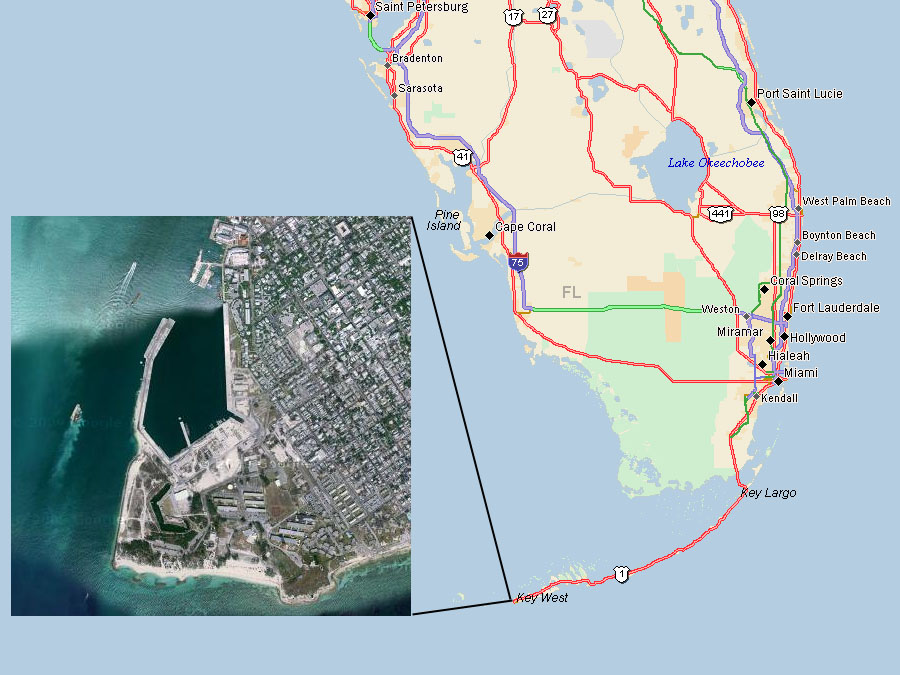 |
||
| Key West. The picture shows the harbor as it is today. The map below shows where the Submarine piers were. Arial photo courtesy Google maps. |
||
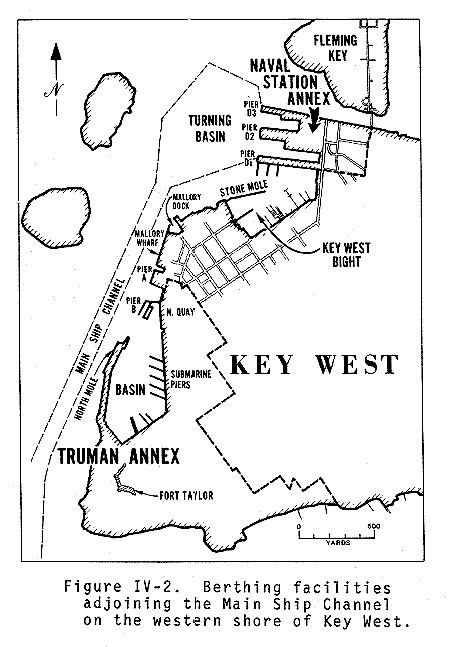 |
||
| Key West is another example of the United States - and more specifically the United States Navy not learning from the past. The Navy's first presence in Key West was only as a passing convenience through most of the 1800's. It's not that some in the Navy didn't recognize Key West's potential and the importance of it's location - Commodore Porter noted in 1823 that Key West should become the "Gibraltar of the Gulf" - it's just that he was one of a few that could so clearly see what others didn't - so it would be many years - and several world-changing events before it that would become a reality. Key West did become a "Port of Entry" for wrecks in the region in 1828 (see the Federal Wrecking Act of 1825) - and the processing and selling of salvaged property became a primary economic activity. As shipping became more modernized (and less shipwrecks occurred) warehousing, processing and disposition of confiscated contraband overtook wrecking as the primary economic engine - and the Navy became more involved with matters in Key West - but still had only a very small official presence. During various wars and civil unrest of the mid to late 1800s - the Army had beefed up defenses at Key West - ranging from building of Fort Taylor (begun in 1845 - and rebuilt after the great hurricane of 1846) to strengthening the Union Army's holdings during the Civil War (Key West was taken by the Union Army on the night of January 13, 1861 - since there was such a large compliment of Union soldiers manning Fort Taylor). Key West was of great importance during the Civil War - due to it's location on the South's trade routes - and the desire by the Union to blockade that trade. The Army ran "the town" of Key West - while the Navy ran the Port. Piers and warehouses became a top priority for handling the goods seized by the Navy. After the Civil War - the Navy reduced it's presence to a token level - basically abandoning it's facilities to the cigar and sponge industries. It appeared that things would remain this way as the 19th century came to a close - but then Key West found itself plunged into the middle of another war - and this time - Key West was directly involved. During the last decade of the 19th century - there was a growing movement for Cuban independence from Spain. Hostilities began in 1895 - and many people made a large effort to drag the United States into the war. While the United States made great efforts to appear neutral (and to not violate neutrality laws) - there were covert efforts made to help those fighting Spain. The United States supplied help in the form of transportation by ship. Again - in an effort to appear to be neutral - troops were loaded aboard one ship - while arms were loaded aboard another. They would then sail deliver their "cargoes" arriving by different routes. One such "peace mission" was undertaken by the Maine. She sailed from Key West - and eventually made a port call at Havana. February 15th, 1898 - she exploded and sank - taking some 261 of her 355 man crew with her. The Navy immediately beefed up their Key West facilities to support the war effort against Spain. However - once again - once the hostilities were over- the Navy reduced it's presence at Key West - leaving only enough support infrastructure to support some training in the Caribbean. When World War I was raging in Europe- the United States realized - nearly too late - that preparations needed to be made. Land was rented from the Florida East Coast Railway - and construction started on a Naval Air Base. The base was had two missions: the first as a coastal patrol base - and the second was for training Naval Aviators. The Air plane and Lighter Than Air Ships were ideal for patrolling the vast coastal regions of South Florida. A building and expansion program in the downtown and port area was begun for facilities for Destroyers and Submarines. Germany was proving the submarine was a most formidable attack weapon - the United States Navy to this point had only considered them a defensive weapon. At one point during WWI German submarines were sinking shipping during daylight within sight of Key West. The Navy concentrated on aerial anti-submarine warfare in response to the German raiders. While primitive (there are stories of the gunners on Naval Airplanes dropping hand-grenades into the open hatches of surfaced German Submarines - and doing more damage than they could with their guns) -- the Navy managed to greatly reduce the damage done by German submarines by the middle of the war. The Navy's concentration at this time was so focused on Aviation - that the submarine base wasn't completed until 1932 - then virtually abandoned. Most of the Navy Base was closed. With war once again raging in Europe - the Navy once again set about trying to prepare. First step was to announce on that the Naval Station would re-open on November 1, 1939. Before the end of the year - the Navy had singed a contract for Trumbo Point and announced a Naval Air Station would be built there. The mission of the base was expanded in mid 1940 when the Fleet Sonar School was established - which would train Navy SONAR operators until the early 1970s. Finally - after several starts and misfires - Key West became the "Gibraltar of the Gulf" that Commodore Porter envisioned in 1823. During WWII Key West Naval Station and Key West Naval Air Station were built-up and provided extremely valuable support - with military population reaching a high of 15,000. | ||
 |
||
| An aerial view of the port facilities with the submarine and destroyer piers. Note the Tender just above the submarines. The date of this photo is unknown, however it's likely that the tender is USS Howard W. Gilmore. Photo courtesy Sherman McGee |
||
|
|
||
|
After WWII - Submarine Squadron Four and a destroyer squadron were stationed at Key West after WWII - with USS Howard W. Gilmore tending the submarines. In 1952 a second Submarine Squadron (TWELVE) also home ported at Key West - with tender USS Bushnell. Along with the training operations at Naval Station Key West and Naval Air Station Key West - the military's presence was immense. 1959 saw a significant reduction when USS Howard W. Gilmore departed Key West - taking Submarine Squadron Four with her to Charleston, South Carolina. The Cuban Missile crissis of 1962 caused Howard W. Gilmore to return to the region - where she (along with USS Bushnell still at Key West) tended the submarines that President Kennedy pressed into blockade and surveillance service during that incident. After the Soviet Threat was removed - USS Howard W. Gilmore returned to Charleston with Submarine Squadron Four. After that time - the Navy (as well as the United States military in general) began a long process of reducing their presence on Key West. |
||
 |
||
| Naval Station Key West entrance. Notice the1938 Haramaki, HA 19, Japanese Type A (Mato) Midget Submarine next to the building on the left just through the gate. Photo courtesy Sherman McGee |
||
|
|
||
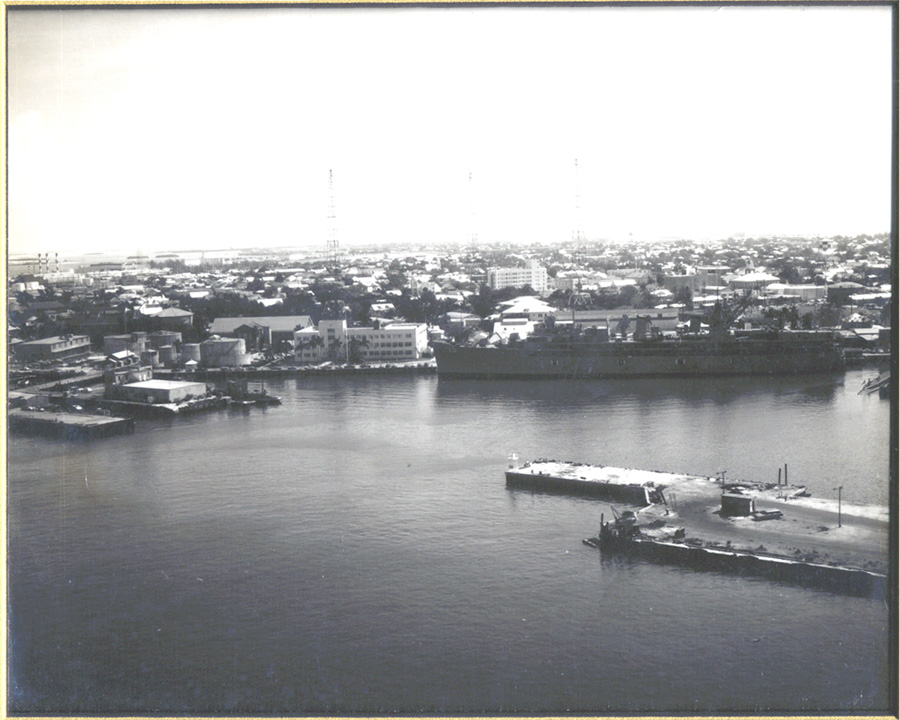 | ||
| USS Bushnell at the pier tending units of Submarine Squadron Twelve. | ||
|
|
||
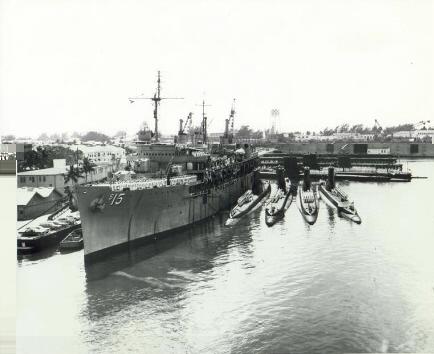 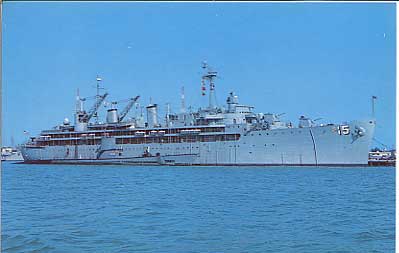 |
||
|
||
|
|
||
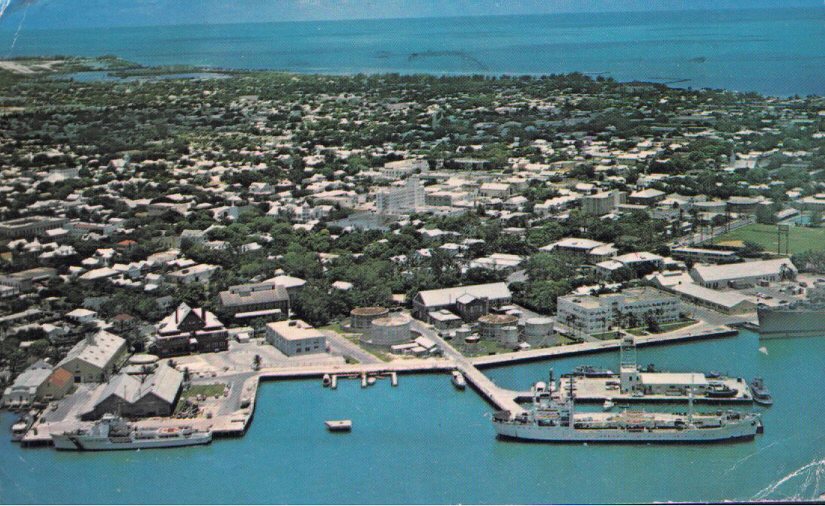 |
||
| Another view of Key West - likely mid 60s. USS Bushnell's bow can be seen at the far right. Photo courtesy Sherman McGee |
||
|
|
||
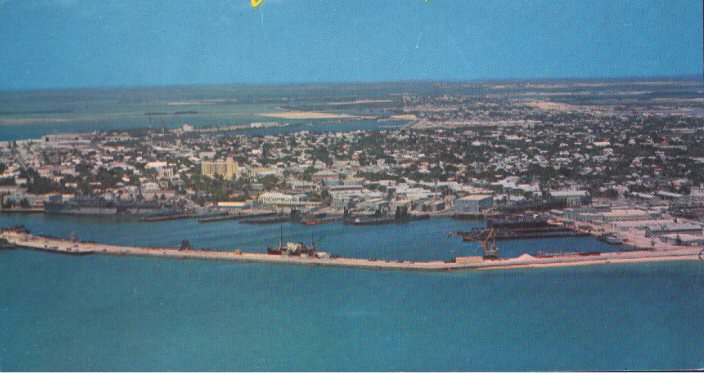 |
||
| Key West - looking almost due east across the basin. Photo courtesy Sherman McGee |
||
|
|
||
| In 1970 - USS Bushnell suffered serious damage from a bilge fire - from which she would not recover. USS Gilmore moved from Charleston to Key West to relieve her - taking over the duties of tending Submarine Squadron Twelve. As noted, the Navy was already reducing it's presence in Key West - and in 1972 both Submarine Squadron Twelve and Destroyer Squadron Twelve were deactivated and their units moved to other bases. This left Naval Station Key West with little but the Fleet SONAR School - which was closed and moved to New London. With basically no mission left - March 29, 1974, Admiral John Maurer ordered his flag struck - closing the Key West Naval Station. Today - except for Naval Air Station Key West - virtually all of the facilities of former Naval Station Key West have been turned over to civilians for development - only the piers remain the property of the United States Navy. And as can be seen in the aerial photo at the top - most of those have been dismantled and removed. If there is another crisis arises in the region requiring a large-scale Naval military response - the U.S. Navy will find itself once again - starting from very nearly scratch. | ||
|
|
||
| Thanks to Sherman McGee for help with this page. | ||
|
|
| Go Back to Deployments - Guam | Continue on to Deployments - Charleston |
| Return to TenderTale Main Page © 2010 Common Cents Computers | |